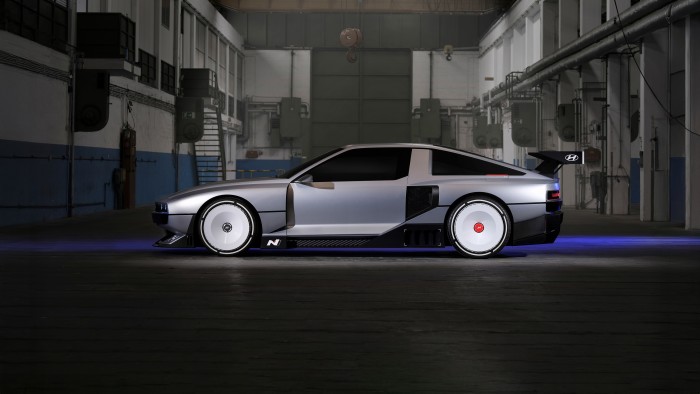Unlock the Editor’s Digest for free
Roula Khalaf, Editor of the FT, selects her favourite stories in this weekly newsletter.
Lee SangYup put his ballpoint pen to paper and began sketching. A folding tray table, during a bumpy flight, was not the smoothest surface on which to draw. But the straight lines and sharp angles he had in mind came anyway. It was 2016, and Lee was on his way home to South Korea after more than two decades abroad. When he emigrated in 1995, Lee was a trained sculptor from a poor country without much automotive heritage. He studied at the ArtCenter College of Design in Pasadena, in the heart of American car culture, and then rose through the design ranks at General Motors, Volkswagen and Bentley. Lee’s designs refracted wildly disparate cultural and aesthetic inputs, from the angst of the American male to the quirks in British notions of luxury.
At GM, he’d composed power ballads in the form of concepts, including the Cadillac Sixteen and Stingray Corvette. For Bentley, he’d helped define a design language that spoke of the future, not just the past. Lee’s designs told a story about what a brand once meant and could again. The cars that made it into production, such as the Chevrolet Camaro, sold like hot cakes. “I am a creation of my mentors,” Lee says graciously, before namechecking some of the legendary designers for whom he’s worked.
A few months after returning to Korea, Lee began to work at Hyundai Motor Company, where he now heads its Global Design Center. Since then, he has helped move the firm from a fast follower to first mover, with a torrent of bold concepts and bestselling production vehicles. There is a serious argument to be made that the company now has the most progressive design organisation in the industry.
Hyundai’s Ioniq line of electric vehicles is a case in point. As many major carmakers struggled to find a footing in EVs, Lee encouraged a break with industry tradition. Typically, the design language that defines a car brand begins with the shape of the front grille, a functional necessity in vehicles with an internal combustion engine. This front face is then resized and tweaked between various models to create a “family look”. BMW’s kidney-shaped grille, for example, is what tells you that’s a 3 Series in the rear-view, even at 70 miles per hour. “This approach is a bit egoistic,” Lee says, laughing. “If all cars look the same, how does that really serve the customers?”
Because EVs don’t need front grilles, Lee chose not to sweat the loss of the “brand identifier”. As a result, the angular Ioniq 5 doesn’t appear to have all that much in common with the swoopy Ioniq 9 SUV. But the 5’s designers were free to max out cabin space, whereas for the SUV they focused on fine-tuning energy efficiency. The vehicles achieve visual continuity, Lee says, through similar digital headlamps.
The car Lee was drawing on the flight, meanwhile, was inspired by a little-known artefact of history he had stumbled upon in a book. Designed in 1974 by the Italian stylist Giorgetto Giugiaro, the Hyundai Pony Coupe concept was a piece of sheet-metal origami, with a wedge-shaped nose and circular headlamps that clearly influenced the DeLorean DMC 12. But the Coupe, an outrageously ambitious statement of intent for the then-upstart Korean company, was never produced.
In a slim volume she wrote about her friend Pablo Picasso in 1938, Gertrude Stein described flying in an aeroplane for the first time. Looking at Earth from this new vantage, she suddenly saw the “mingling lines of Picasso coming and going”, although he had never flown. Great artists, she concluded, understand what is contemporary when their contemporaries don’t yet recognise it. The lines Lee drew on the flight in 2016 are the same. Lee was drawing the zeitgeist before it was the zeitgeist – the beginning of a story, he says, intended to unify “past, present and future”. They eventually inspired the N Vision 74, unveiled in 2022. Easily the most important concept car of the past decade, it is a cyberpunk fever dream with 1980s touchpoints: rear window louvres, box arches, turbofan wheels. Technically, it was powered by a battery and hydrogen fuel cell, but it wouldn’t have mattered if it ran on liquefied baby unicorns. People went nuts for it. (A limited production version is reportedly due next year.)
When the N74 broke the internet, many people said it was due to nostalgia. But “it is not a retro car”, Lee says, as he walks me around the design. “Every element has a reason.” I point out that the angled line of the corner of the door window is replicated in the bottom line of the side air intake and the strakes on the lower side moulding. He laughs and tells me I missed the matching lines on the edge of the rear window and spoiler.
This sort of attention to detail isn’t only extremely difficult to get right. It’s what makes the N74 look like a plausible artefact from an alternate future. More importantly, for Lee, it tells a story about a once-fledgling auto company that has become a global leader. “It’s a heart-touching story that everybody can respect,” he says. He’s talking about his company and his country.
Read the full article here

